Tunxis Trail
| Tunxis Trail | |
|---|---|
 Cussgutter Brook in Winter - Tunxis Compounce Cascade Side Trail | |
| Length | 79 mi (127 km) |
| Location | Hartford / New Haven counties, Connecticut, USA |
| Designation | CFPA Blue-Blazed Tunxis Trail System |
| Use | hiking, cross-country skiing, snowshoeing, other |
| Elevation | |
| Highest point | Pine Mountain, 1,378 ft (420 m) |
| Lowest point | Farmington River, 150 ft (46 m) |
| Hiking details | |
| Trail difficulty | easy, with difficult sections |
| Season | easiest spring to fall |
| Hazards | hunters, deer ticks, poison ivy |
The Tunxis Trail is a 79-mile (127 km) Blue-Blazed hiking trail "system" that traverses the western ridge of the central Connecticut valley. The mainline (official "Blue" and "non-dot") trail is not completely contiguous, notably there are two gaps of several miles (between the Southington and Burlington sections and between the Burlington section and the Nepaug section).
The Tunxis Trail is composed of eighteen (18) trails of which one is the primarily North-to-South mainline trail plus a number of shorter side trails. Despite being easily accessible and close to large population centers, the trail is considered remarkably rugged and scenic.
Notable features include the Lake Compounce Amusement Park (and its "non-ski lift"), "Tory Den", the "Mile of Ledges", colonial era cemeteries, several caves (including the "Indian Council Caves"), waterfalls, dramatic cliff faces, woodlands, swamps, lakes, river flood plains, farmland, significant historic sites, and the summits of Pine Mountain and Southington Mountain.[1] The Tunxis Trail, maintained largely through the efforts of the Connecticut Forest and Park Association.
The Tunxis Trail system, at approximately 79 miles in length, is the longest of the Blue-Blazed Trails maintained by the Connecticut Forest and Park Association.
Because the trail runs parallel to the Metacomet Trail there are several spectacular views from the Tunxis Trail of Metacomet Ridge features to the east.
Trail description

The Tunxis Trail extends from the Connecticut / Massachusetts border north to south crossing successively the municipalities of Hartland in Hartford County, Barkhamsted and New Hartford in Litchfield County, Canton and Burlington in Hartford County, Harwinton and Plymouth in Litchfield County, ending in Bristol and Southington in Hartford County with two southern side trails touching the northern New Haven County town of Wolcott.
The southern terminus of the trail is located just north of the Mount Southington ski resort at the intersection of Mount Vernon Road and Whitman Road at a courtesy parking lot provided by the Southington Sportsmen Association, in the town of Southington, Connecticut; the northern terminus is located on the Connecticut / Massachusetts state line where Connecticut's Tunxis State Forest and Massachuesett's Granville State Forest meet, part of Hartland, Connecticut, south of Granville, Massachusetts. The Metacomet Ridge (in particular central Connecticut high points such as the Hanging Hills, Ragged Mountain (Connecticut) and Talcott Mountain—including Heublein Tower) is visible to the east from much of the Tunxis Trail.
Significant networks of shorter hiking trails (17 official "Blue-Blazed" regional trails) intersect with the Tunxis Trail in the three southern sections—in the Southington region (from Wolcott to the New Britain Reservoir and in Bristol near the Lake Compounce Amusement Park), the Burlington Region, and in Nepaug State Forest (New Hartford).
The Tunxis Trail is primarily used for hiking, backpacking, picnicking, and in the winter, snowshoeing. Portions of the trail are suitable for, and are used for, mountain biking and cross-country skiing. Site-specific activities enjoyed along the route include hunting, fishing, horseback riding, boating, bouldering, rock climbing (access), and swimming.[1][2]
Trail route
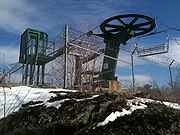
The Tunxis Trail traverses the western ridge of the central Connecticut valley which extends from Long Island Sound to the Massachusetts/ Vermont border.
This western ridge, overlooking the Connecticut River, Farmington River, and Quinnipiac River valleys, is a prominent landscape feature of western central Connecticut.
From south to north, the trail system summits or travels near by the ridges and peaks of Southington Mountain (including Libby's Lump, Peter's Lookout), Johnnycake Mountain, Taine Mountain / Perry’s Lookout, Wildcat Mountain, Ski Sundown / Ratlum Mountain, Pine Mountain, Indian Hill.
The Farmington River cuts through the trail just above Nepaug State Forest at the Satan's Kingdom Recreation Area (in New Hartford).
The Tunxis Trail crosses several Connecticut state forests, land/preservation trusts, metropolitan water company properties and private property.
From south to north the trail crosses the Session Woods Wildlife Management Area, Nassahegon State Forest, Nepaug State Forest, Tunxis State Forest, Granville State Forest.
Views from the ledges include agrarian land, suburbs, small towns, river corridors, the eastern Berkshires and Metacomet ridgelines, and metropolitan Bristol.
Trail communities
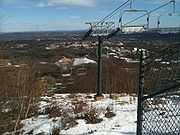
The Tunxis Trail passes through land located within the following municipalities in Connecticut, from south to north: Southington, Wolcott, Bristol, Plymouth, (East Plymouth aka Terryville), Harwinton, Burlington, Canton, New Hartford, Barkhamsted, Hartland as well as Granville, Massachusetts [1][3]
Landscape, geology, and natural environment
The Tunxis Trail follows the western wall of the geologic formation known as the Hartford Basin.[4]
History and folklore
Origin and name
The name Tunxis is said to be the indigenous term (in the native American Wuttunkshau language] for the "point where the river bends" in the middle of the Farmington River between the towns of Farmington and Southington Connecticut.[5]
The original form of the name used was properly "Tunxis Sepus" (translated as "little bend in the river").
Connecticut's Farmington River was also known as the Tunxis River (particularly in the localities of New Hartford, Burlington, Farmington, Avon, Simsbury and Granby) to the English colonists during the middle of the 17th century. [6]
"Tunxis" is also a name given to the native American sub-tribe (of the Saukiogs tribe) living in the area between and including where the towns of Farmington and Southington Connecticut exist today.
They were the subjects of the sachem Sequassen (who sold the Hartford area to the English) and to have—in 1610—have sold off most of their territory. A group of twenty wigwams existed in Farmington at the beginning of the eighteenth century but only four or five families existed in the settlement by 1761 [7]
When white Europeans first arrived the "Tunxis Sepus" territory consisted of a 165 mile square area bounded by Simsbury to the North, Wallingford to the South, northwest to Mohawk country and on the east by the current towns of Windsor, Hartford and Wethersfield. In 1645 the Town of Farmington Connecticut was named by the Connecticut General Assembly and this was re-affirmed in 1650 by the execution of a deed by the General Assembly and the reservation of land for the "Tunxis Indians" near "Indian Neck" on the east bank of the Farmington River.[7]
For more information on the Tunxis native-Americans ("American Indians") see the Wikipedia entry on the Tunxis.
Historic sites
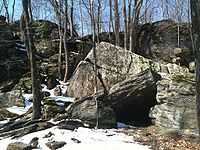
Folklore
There is much American Revolutionary war history associated with the Blue-Blazed White Dot Trail in Plymouth (Terryville) and Harwinton. The locations of several British "loyalist" families are also near the southern terminus of the White Dot Trail in Terryville ( Plymouth, Connecticut) and Harwinton such as the former homestead of Stephen Graves. The Tory Den, a boulder cave located to the west of the "Miles of Ledges" on the border of Terryville ( Plymouth, Connecticut) and Burlington, was a hiding place for Loyalists during the American Revolution.
There are many "satanic" references in place names along the Tunxis Trail—usually dating back to colonial American times.
The "Devil's Kitchen" is an interesting box (also called a "cloven") canyon formation through which the Blue-Blazed Orange Dot Trail passes in Burlington.
"Satan's Kingdom" north of Nepaug State Forest was considered a territory of rogues and unsavory elements during the colonial American era. It is now noteworthy as a launching area for a commercial white-water "tubing" concession on the Farmington River.
The Ski Sundown ski area was known as Satan's Ridge Ski Area when it first opened in 1963 until it was sold in 1969. [8] [9]
Hiking the trail
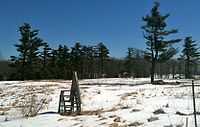
The mainline Tunxis trail is blazed with blue rectangles. It is regularly maintained, and is considered easy hiking, with sections of rugged and moderately difficult hiking. However the "Mile of Ledges" in Burlington requires an amount of rock climbing and the northernmost "wilderness" twenty miles contains both higher elevation and changes in elevation. The Tunxis Trail is generally close to public roads. However, in the Burlington areas many of the roads are unpaved and the northernmost twenty miles are much more remote and even farther from paved roads. There are camping facilities along the northern portions of the trail in the Nepaug and Tunxis State Forests. Camping is generally prohibited in the southern sections (Southington and Burlington). Trail descriptions are available from a number of commercial and non-commercial sources, and a complete guidebook is published by the Connecticut Forest and Park Association
The mainline trail consists roughly of four unbroken sections—Southington (Southington, Wolcott and Bristol), Burlington (Plymouth, Harwinton, Burlington), Nepaug (Burlington, New Hartford) and the northern twenty miles north of route 44 (New Hartford, Canton, Barkhamsted and Hartland).
Weather along the route is typical of Connecticut. Conditions on exposed ridge tops and summits may be harsher during cold or stormy weather.[10] Lightning is a hazard on exposed summits and ledges during thunderstorms. Snow is common in the winter and may necessitate the use of snowshoes. Ice can form on exposed ledges and summits, making hiking dangerous without special equipment. [11]
Extensive flooding in ponds, puddles and streams may occur in the late winter or early spring, overflowing into the trail and causing very muddy conditions. In this case fairly high waterproof boots are recommended.
Biting insects can be bothersome during warm weather. Parasitic deer ticks (which are known to carry Lyme disease) are a potential hazard.[11]
The southern sections of trail can be very close to civilization (suburban homes, streets and businesses) and often contain ruts from ATVs. The middle sections (Burlington, Nepaug) contain many forest roads, dirt roads and paved road walks. The Nepaug section can contain weirdness along the trail (lots of cairns, Christmas tree ornaments on tree branches, perfectly spaced pine tree forests as a result of forest management experiments).
Much of the trail is adjacent to, or is on lands where hunting and the use of firearms are permitted. Wearing bright orange clothing during the hunting season (Fall through December) is recommended.
Conservation and maintenance of the trail corridor
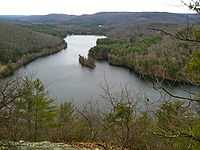
See also
- Blue-Blazed Trails
- Mattatuck Trail
- Metacomet Ridge
- Metacomet-Monadnock Trail
- Metacomet Trail
References
- ↑ 1.0 1.1 1.2 Connecticut Walk Book: A Trail Guide to the Connecticut Outdoors. 17th Edition. The Connecticut Forest and Park Association. Rockfall, Connecticut. Undated.
- ↑ Connecticut Department of Environmental Protection. Cited Dec. 21, 2007
- ↑ DeLorme Topo 6.0. Mapping Software. DeLorme, Yarmouth, Maine
- ↑ Raymo, Chet and Maureen E. Written in Stone: A Geologic History of the Northeastern United States. Globe Pequot, Chester, Connecticut, 1989.
- ↑ Trumbull, http://www.accessgenealogy.com/native/tribes/tunxishist.htm
- ↑ New England Gazetteer: Containing Descriptions of the States, Counties, Cities and Towns of New England, John Hayward, 1857, Second Edition
- ↑ 7.0 7.1 http://www.farmingtonlibraries.org/qhistoryoffarmington.htm
- ↑ http://www.registercitizen.com/articles/2009/02/04/business/doc49892b866accb642611713.txt
- ↑ http://www.countytimes.com/site/news.cfm?BRD=2303&dept_id=478843&newsid=20246613&PAG=461&rfi=9
- ↑ NOAA
- ↑ 11.0 11.1 http://en.wikipedia.org/wiki/Metacomet_Trail
External links
Specific to this trail:
- CT Museum Quest - Tunxis Mainline Trail
- CT Museum Quest - Tunxis Mainline Trail Section 1 - Southington Section
- CT Museum Quest - Tunxis Mainline Trail Section 2 - Plymouth/Burlington Section
- CT Museum Quest - Tunxis Mainline Trail Section 3 - Burlington Section
- CT Museum Quest - Tunxis Mainline Trail Section 4 - Nepaug Section - Burlington/New Hartford
- CT Museum Quest - Tunxis Trail Southington Regional Trails South
- CT Museum Quest - Tunxis Trail Southington Regional Trails North
- CT Museum Quest - Tunxis Trail Burlington Regional Trails West
- CT Museum Quest - Tunxis Trail Burlington Regional Trails North/East
- CT Museum Quest - Tunxis Trail Burlington Regional Trails South
- CT Museum Quest - Tunxis Trail Nepaug Section Regional Trails
State and Municipal Government Web Resources:
- State of Connecticut - Session Woods Wildlife Management Area
- State of Connecticut - Session Woods Wildlife Management Area map
- - Session Woods, A Guide by Tess B. Bird
- Connecticut Nassahegon State Forest map
- Connecticut Nassahegon State Forest Letterboxing Clues
- Connecticut Nepaug State Forest map
- Connecticut Nepaug State Forest campground map
- Connecticut Nepaug State Forest Letterboxing Clues
- Connecticut Tunxis State Forest Overview map
- Connecticut Tunxis State Forest Roaring Brook Camping Area map
- Connecticut Tunxis State Forest Hurricane Brook Shelter map
- Connecticut Tunxis State Forest Letterboxing Clues
- Commonwealth of Massachuesetts, Granville State Forest
- Town of Southington, Connecticut website
- Town of Wolcott, Connecticut website
- City of Bristol, Connecticut website
- Town of Plymouth, Connecticut including Terryville
- Town of Harwinton, Connecticut website
- Town of Burlington, Connecticut website
- Town of Canton, Connecticut including Collinsville
- Town of New Hartford, Connecticut including Collinsville
- Town of Barkhamsted, Connecticut website
- Town of Hartland, Connecticut website
Land Trust and Conservation/Preservation Organizations:
- Connecticut Forest and Park Association
- Farmington River Coordinating Committee
- Farmington River Watershed Association
- Southington Land Conservation Trust
- Wolcott Land Conservation Trust
- Plymouth Land Trust
- Harwinton Land Trust
- Burlington Land Trust
- Burlington Land Trust Ramblers Guide
- Canton Land Conservation Trust, Inc.
- Hartland Land Trust
- Barkhamsted Land Trust
- Environmental Learning Centers of Connecticut, Inc. (ELCCT)
- Barnes Nature Center - Environmental Learning Centers of Connecticut, Inc. (ELCCT)
- MDC website
- MDC Barkhamsted and Nepaug Area Map
News Articles:
- WebShots - Indian Council Caves, Tunxis Trail, Tunxis State Forest, Barkhamsted, Connecticut
- TC Extra - Take_a_hike_Tunxis_Trail_to_the_Indian_Council_Caves
Further reading
- Books – Connecticut Hiking
- Colson, Ann T. (2005). Connecticut Walk Book East (19 ed.). Rockfall, Connecticut: Connecticut Forest and Park Association. pp. 1–261. ISBN 0961905255.
- Colson, Ann T. (2006). Connecticut Walk Book West (19 ed.). Rockfall, Connecticut: Connecticut Forest and Park Association. pp. 1–353. ISBN 0961905263.
- Emblidge, David (1998). Hikes in southern New England: Connecticut, Massachusetts, Vermont (1 ed.). Mechanicsburg, Pennsylvania: Stackpole Books. pp. 1–304. ISBN 0-8117-2669-X.
- Keyarts, Eugene (2002). Pietrzyk, Cindi Dale, ed. Short Nature Walks: Connecticut Guide Book (7 ed.). Guilford, Connecticut: Falcon Publishing. pp. 1–192. ISBN 0-7627-2310-6.
- Laubach, Rene; Smith, Charles W. G. (2007). AMC's Best Day Hikes in Connecticut (1 ed.). Guilford, Connecticut: Appalachian Mountain Club Books. pp. 1–320. ISBN 1-934028-10-X.
- Ostertag, Rhonda; Ostertag, George (2002). Hiking Southern New England (2 ed.). Guilford, Connecticut: Falcon Publishing. pp. 1–336. ISBN 0-7627-2246-0.
- Books – Connecticut History and Geography
- De Forest, John (1853). History of the Indians of Connecticut from the earliest known period to 1850. Hartford, Connecticut: Wm. Jas. Hamersley. pp. 1–509.
- Hayward, John (1857). New England Gazetteer: Containing Descriptions of the States, Counties, Cities and Towns of New England (2 ed.). Boston, Massachusetts: Otis Clapp. pp. 1–704.
- Trumbull, Benjamin (1797). Volume One A Complete History of Connecticut - Civil and Ecclesiastical. Volume I (1818 printing ed.). New Haven, Connecticut: Maltby, Goldsmith & Co. and Samuel Wadsworth. pp. 1–1166.
- Trumbull, Benjamin (1797). Volume Two A Complete History of Connecticut - Civil and Ecclesiastical. Volume II (1818 printing ed.). New Haven, Connecticut: Maltby, Goldsmith & Co. and Samuel Wadsworth. pp. 1–1166.
| |||||||